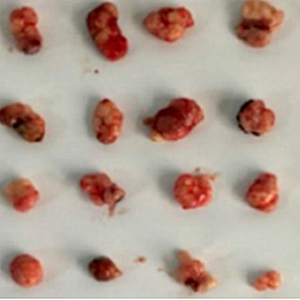Lobetyolin suppressed lung cancer in a mouse model by inhibiting epithelial-mesenchymal transition

Accepted: 24 June 2022
HTML: 47
All claims expressed in this article are solely those of the authors and do not necessarily represent those of their affiliated organizations, or those of the publisher, the editors and the reviewers. Any product that may be evaluated in this article or claim that may be made by its manufacturer is not guaranteed or endorsed by the publisher.
Authors
Traditional Chinese medicines are gaining more attention as promising adjuvant agents for conventional chemotherapy. Recent studies have shown that lobetyolin (LBT) is one of the main bioactive compounds of traditional Chinese medicines and it exhibits anticancer activity in several types of cancer. Therefore, this study aimed to investigate the mechanism by which LBT inhibits lung cancer. A549 human lung cancer cells were treated with LBT. In addition, A549 cells were injected into Balc/b nude mice to establish model of lung cancer. The mice were treated with cisplatin (DDP) or LBT alone or in combination, and tumor growth was monitored. Protein levels of E-cadherin, vimentin and matrix metalloproteinase 9 (MMP9) were detected. We found that the combination of LBT and DDP showed stronger effect to inhibit the proliferation of A549 cells compared to LBT or DDP treatment alone. Wound healing assay showed that the ratio of wound healing was significantly lower in LBT group and DDP group and was the lowest in LBT+DDP group. Transwell invasion assay showed that the invasion ability of A549 cells was the weakest in LBT+DDP group. Protein levels of E-cadherin were the highest while those of vimentin and MMP9 were the lowest in A549 cells treated with LBT+DDP. Nude mouse xenograft tumor model showed that the combination of LBT with DDP had the highest efficacy to inhibit the growth of lung cancer, and tumor tissues of mice treated with LBT+DDP had the lowest expression of vimentin and MMP9 and the highest expression of E-cadherin. In conclusion, LBT significantly enhances the efficacy of chemotherapy on lung cancer, and the mechanism may be related to the inhibition of epithelial-mesenchymal transition.
Ethics Approval
The animal use protocol has been reviewed and approved by the Animal Care and Use Committee of The First Hospital of Qiqihar, China (No. 072564)How to Cite

This work is licensed under a Creative Commons Attribution-NonCommercial 4.0 International License.
PAGEPress has chosen to apply the Creative Commons Attribution NonCommercial 4.0 International License (CC BY-NC 4.0) to all manuscripts to be published.

 https://doi.org/10.4081/ejh.2022.3423
https://doi.org/10.4081/ejh.2022.3423






